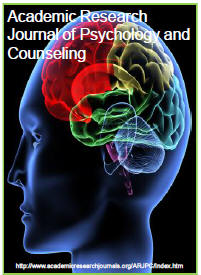| ARJPC |
Academic
Research Journal of Psychology and Counselling |
||||||||||||||||||||
|
Academic Research Journal of Psychology and Counselling Vol. 1(5), pp. 54-58, October, 2014. ISSN: 2384-6178©2014 Academic Research Journals Research Paper Cue exposure cognitive behavior therapy in relapse and craving control among alcoholic young adults at selected rehabilitation centres in Uasin Gishu County, Kenya.
Chege Kimani Gabriel
Department of Sociology & Psychology, Moi University, Kenya. E-mail: ckimani78@yahoo.com
Accepted 26 October 2014
Cue exposure cognitive behavior therapy in relapse and carving control
among alcoholic young adults at selected rehabilitation centres. The
objectives of the study were: 1) to investigate the effect of duration
of cue exposure on the alcoholic’s resistance to relapse; (2) to
investigate the effect of the nature of cue exposure on the alcoholic’s
resistance to relapse; and: (3) to investigate the effect of length of
CET session son resistance to relapse. The study population and sample
comprised 78 clients or patients who were enrolled in two rehabilitation
centres in Uasin Gishu County, Kenya. The study adopted the experimental
research design. The measurement of relapse was done using a check list
on the quantity/frequency of drinking during drinking episodes as well
as the Alcohol Timeline Follow back (TLFB) interview while the craving
scale was used to measure clients’ carving for alcohol. A total of 39
patients were exposed to drinking cues in vivo while the other one was
exposed to the same through imagination. The CET sessions lasted between
1 hour and 5 hours for every exposure situation over a period of three
months. Again, on group underwent CET for 45 days while the other
underwent CET for 90 day to s in order to determine the role of duration
of exposure to CET in preventing relapse. Follow-ups were done 3 months
thereafter. Study data was analyzed using regression analysis,
presenting results for both the t-statistic and ANOVA. Based on the p
values obtained (p=.007<.05 for cue exposure), (p=.020<.05 for the
nature of Cue exposure therapy) and (p=.018<.05 for length of CET
sessions), all the null hypotheses were rejected. This implied that
duration of cue exposure, the nature of Cue exposure therapy and length
of CET sessions significantly predicted resistance to relapse. The study
recommends that for better results, cue exposure should be applied as an
adjunctive therapy to a more comprehensive treatment program in order to
improve treatment outcome. Cite This Article As: Gabriel CK (2014). Cue exposure cognitive behavior therapy in relapse and craving control among alcoholic young adults at selected rehabilitation centres in Uasin Gishu County, Kenya. Acad. Res. J. Psychol. Counsel. 1(5): 54-58.
|
|||||||||||||||||||||
|
|
||||||||||||||||||||
